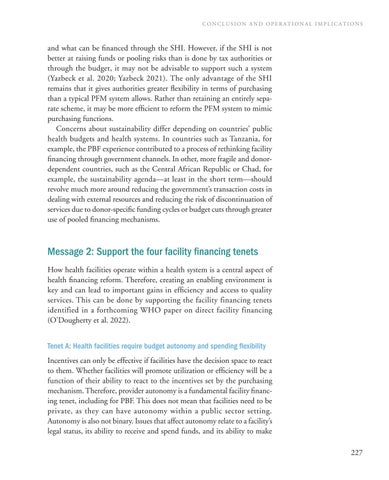C onclusion and O perational I mplications
and what can be financed through the SHI. However, if the SHI is not better at raising funds or pooling risks than is done by tax authorities or through the budget, it may not be advisable to support such a system (Yazbeck et al. 2020; Yazbeck 2021). The only advantage of the SHI remains that it gives authorities greater flexibility in terms of purchasing than a typical PFM system allows. Rather than retaining an entirely separate scheme, it may be more efficient to reform the PFM system to mimic purchasing functions. Concerns about sustainability differ depending on countries’ public health budgets and health systems. In countries such as Tanzania, for example, the PBF experience contributed to a process of rethinking facility financing through government channels. In other, more fragile and donordependent countries, such as the Central African Republic or Chad, for example, the sustainability agenda—at least in the short term—should revolve much more around reducing the government’s transaction costs in dealing with external resources and reducing the risk of discontinuation of services due to donor-specific funding cycles or budget cuts through greater use of pooled financing mechanisms.
Message 2: Support the four facility financing tenets How health facilities operate within a health system is a central aspect of health financing reform. Therefore, creating an enabling environment is key and can lead to important gains in efficiency and access to quality services. This can be done by supporting the facility financing tenets identified in a forthcoming WHO paper on direct facility financing (O’Dougherty et al. 2022). Tenet A: Health facilities require budget autonomy and spending flexibility Incentives can only be effective if facilities have the decision space to react to them. Whether facilities will promote utilization or efficiency will be a function of their ability to react to the incentives set by the purchasing mechanism. Therefore, provider autonomy is a fundamental facility financing tenet, including for PBF. This does not mean that facilities need to be private, as they can have autonomy within a public sector setting. Autonomy is also not binary. Issues that affect autonomy relate to a facility’s legal status, its ability to receive and spend funds, and its ability to make 227

